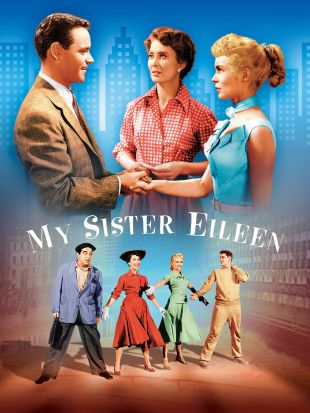Actor/dancer Tommy Rall is, rather unfairly, something of the odd man out in the pantheon of MGM musical stars. In a way, it's almost understandable how this would occur -- he only appeared in three of the studio's productions. Two of those three, however -- Kiss Me Kate and Seven Brides for Seven Brothers -- were among MGM's biggest hits of the 1950s, and Rall was prominent in both, yet he is hardly ever mentioned in discussions of either film. His lack of recognition for his work in Kiss Me Kate, in which he does a dazzling rooftop dance (which looks even more impressive in the restored 3-D version of the film) set to Cole Porter's "Why Can't You Behave," is particularly frustrating -- true, Bob Fosse did some impressive choreography on "From This Moment On" from the same movie, and Howard Keel, Kathryn Grayson, and Ann Miller were never funnier or better -- but Rall also should be better noticed than he is.
Born in Kansas City, MO, in 1929, but raised in Seattle, WA, Rall became a dancer by accident, starting at the age of four. His eyesight had been diagnosed as so poor that his mother, recognizing that any profession involving reading or study would be a problem, thought that dancing would eventually lead him to a career that was within reach. He also proved to be very good at it, and although his eyes ultimately became strong enough after surgery to permit him to study normally, he also discovered that he loved dancing and he never stopped the lessons. By age eight, he was performing in vaudeville in the area around Seattle, and had begun developing his acrobatic skills as well. He made a few tries at a child acting career without much success until the beginning of the 1940s, when Universal Pictures signed him up as part of an entire corps of young juvenile performers that the studio intended for a series of pleasant, low-budget musicals. Rall was cast as one of the Jivin' Jacks and Jills and Jills in Give Out, Sisters (1942), a breezy vehicle for the Andrews Sisters, Dan Dailey, and Grace McDonald. He got a small role (with screen credit this time) in another movie that same year, Get Hep to Love, starring Donald O'Connor and Gloria Jean, but then the company was broken up by the studio and most of the young contract players, including Rall, were released. During his early teens, Rall appeared uncredited in The North Star (1943) as a peasant dancer, and played a similar role in Song of Russia that same year. All the while, he continued studying dance with Adolf Bohm, David Lichine, and Bronislava Nijinska, all of whom facilitated Rall's conversion to the cause of ballet. On Lichine's recommendation, the 14-year-old Rall joined the Ballet Theater company, a touring ensemble, in 1944. He spent three and a half years becoming a seasoned professional while still in his teens, and dancing principal roles. By 1947, he'd gone as far as he could with the company and, for the moment, with ballet, and was ready to make the jump to theatrical work. He made his debut in a West Coast revival of Louisiana Purchase. From there, it was a quick leap to Broadway and small featured spots in Look Ma, I'm Dancing (1948) and Small Wonder, which led to top dancing roles Miss Liberty (1949-1950) and Call Me Madam (1950-1951). Those Broadway performances later payed serious dividends when they were recalled by Gene Kelly, while the latter was preparing his film Invitation to the Dance -- Kelly remembered seeing Rall's work and put him into the most personal of all the films he made at MGM. Meanwhile, television beckoned in the early '50s as Rall joined the production team of The Faye Emerson Show as the program's choreographer. Then it was back to Hollywood, where he put his athletic ability as well as his dancing and acting skills to use in Kiss Me Kate, in the role of Bill Calhoun, the would-be paramour of Ann Miller's showgirl Lois Lane, whose gambling streak and IOUs signed in the name of the show's star, Fred Graham, helps propel the plot. He also got to do that delightful rooftop dance with Miller, one great highlight of a movie filled with them. Rall was also part of the unexpected success of Seven Brides for Seven Brothers, playing Frank Pontipee. Roles in the musical My Sister Eileen and The Second Greatest Sex followed, along with his portrayal of the Flashy Boyfriend in Invitation to the Dance. He also played straight acting roles on occasion, as in Universal's production of Walk the Proud Land, a fact-based Western starring Audie Murphy, in which Rall portrayed a Native American. He was in one of Danny Kaye's more fondly remembered later successes, Merry Andrew, and then Broadway beckoned again in Jose Ferrer's production of Juno, a musical by Marc Blitzstein and Joseph Stein (based on Sean O'Casey's play Juno and the Paycock), in which Rall worked in a cast that included Shirley Booth, Melvyn Douglas, Jean Stapleton, and Sada Thompson. He was busy on Broadway during the 1960s, returning to films for an uncredited appearance (as the Prince in the parody of Swan Lake) in Funny Girl (1968). Rall's next screen appearance was in Pennies From Heaven (1981), and he followed this with That's Dancing (1985) and Dancers (1987), in which he was credited as Thomas Rall. In 1997, he also showed up out of character in the documentary The Making of Seven Brides for Seven Brothers.


